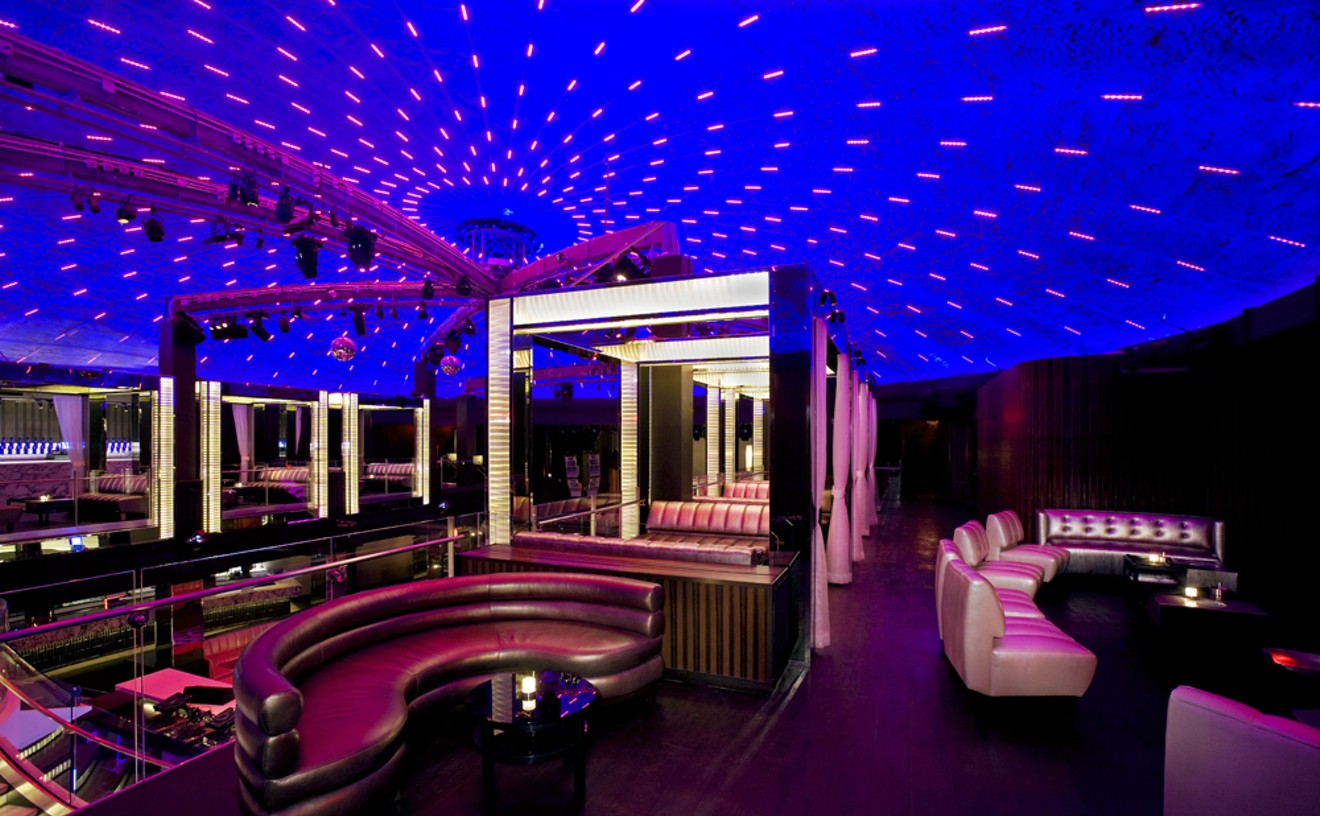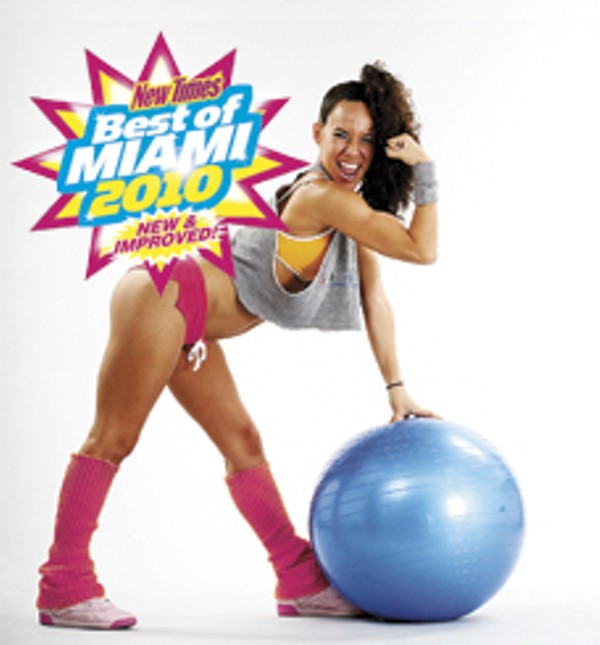Best Rock Club
Random warehouses
Let's face it: Rock clubs per se have a rather tormented history in Miami. In order to survive, venues need to either moonlight as discos or stop strictly curating their lineups. Oh, of course there's Churchill's, but that's an institution, seemingly likely to survive unchanged into the next century. Other than that, most so-called clubs are expensive anyway. The real best places to catch underground rock shows are at warehouses, and there is one for almost every micro-scene. There are the semiofficial spots for the all-ages pop-punk and post-hardcore circuit; the supposed art galleries that are little more than raw space; and the living-working spaces that open their doors to strangers. These spots change names and open and close faster than print allows, but head for the forgotten parts of town. There you'll find the most fun shows for the least money. Good places to check for listings are sorawfestival.com, which maintains an events database of its own and other promoters' shows, and the blog for the Guest Lab (guestlab.tumblr.com), an artsy-minded collective that hosts shows at the venue of the same name, as well as shares information about others.
Best Concert of the Past Year
Ebony Bones! (December 2, 2009)
Miami has a fickle music crowd. Your chances of winning over an audience increase only if you are behind turntables at a megaclub. When Art Basel Miami Beach organizers took a risk in booking British avant-garde R&B-meets-punk songstress Ebony Thomas — AKA Ebony Bones! — it definitely piqued our interest. This postmodern Grace Jones had barely played in front of American crowds, let alone those in Miami. After Yelle's lukewarm reception in 2008, Thomas gave the event the avant-garde jolt it needed. What worked in Thomas's favor was the international crowd that usually makes up any Basel event. Plus her performance featured an enormous backing band, colorful outfits, and an out-of-this-world performance that made it hard to look away. Couple that with an infectious melody that felt retro yet contemporary, and the concert was a highlight during a week that has become Miami's South by Southwest.
Best Nightlife Mistake Corrected
Karu & Y
Everything about Karu & Y seemed wrong from its 2006 opening date. There was the mysterious name, the molecular gastronomy menu, and the confusing layout with concentric rings of warring nightlife "concepts." Then, of course, the most glaring problem: It was a sprawling luxury complex where the average cocktail cost $15 — in Overtown. The moneyed patrons who would frequent the same club on different turf were at first afraid to go; if they confronted their fear, they were escorted by security back to their cars. Everything was tumultuous from there. Chefs were hired and fired, the restaurant closed permanently while the club stayed open, and marquee-name concerts were promised and then failed to materialize. The biggest weekend of the year for the club always seemed to come during Winter Music Conference — a few days' stretch definitely not inhabited by locals. And then, this year, there wouldn't even be WMC for the club. Days before Conference, with little fanfare, party promoters announced the club had been swallowed back into the sprawling event space from whence it came — the formerly next-door Ice Palace Studios. And with that, the median drink price instantly plummeted.
Best Recording Studio
The Hit Factory/Criteria Recording Studios

If you have any notion of paying a couple hundred bucks for your garage band to cut a demo here, quickly dispense with it. The Hit Factory is for the big boys. And to get here — just like Carnegie Hall — you'll have to practice, practice, practice. In the '60s and '70s, the nondescript North Miami converted warehouse complex was a musical oasis for rock and soul musicians. It had amazing acoustics and a serious stockpile of equipment. This was the studio, after all, that cranked out James Brown's "I Feel Good," Fleetwood Mac's "Rumors," and even Black Sabbath's "Heaven & Hell." The studio bustled steadily until it was purchased in 1999 by New York's Hit Factory, officially becoming Hit Factory Criteria. Things only went up from there. While digital setups and updated facilities came in, so too did a new generation of producers and artists of a broader range of genres. These days, the Hit Factory is the local ground zero for high-chart hip-hop, pop, and R&B. The most anointed producers usually take up long-term residence. Scott Storch, for instance, had his own reserved parking space in the golden days. Moving up to the Hit Factory is a coronation of sorts, with the crown this year belonging to hungry young industry stars such as Usher- and Beyoncé-hit-maker Rico Love. No matter who's there, though, the studio remains the star, its storied history and great acoustics imbuing every track with a bit of rub-off magic.
- 1755 NE 149th St., North Miami, 33181 Map
- 305-947-5611
- www.criteriastudios.com
Best Record Label
Roofless Records
These days, it takes major cojones to bother starting a record label, the kind that makes physical product and sells it. That's why those who do are usually extremely interesting, willfully obscure, just willful in general, or all three. Enter Matt Preira, a 24-year-old devoted to putting out his favorite weirdness and never getting too perturbed about the result. Actually, Preira is onto something. By keeping production small and releasing material only on vinyl or even cassette, the limited-edition cache has attracted a devoted following. Roofless Records has slowly snapped up full runs of releases by, say, underground house party bands from Tampa, or "psalms for lonely slackers," as the label's site describes a cassingle by local act Flux Forces. While Preira's output is idiosyncratic, to say the least, his great contribution to the scene is promoting shows under the Roofless banner. At venues such as Harvey's at the American Legion on the Upper Eastside, or at Bar in downtown Miami, he continually showcases the latest exciting bands from Miami, the rest of the country, and outer space.
Best Weekly Party
Dirty Hairy

Courtesy of LIV
Conceived in February 2009 by downtown revelers Poplife and Overthrow, Wednesday night's Dirty Hairy has become the best reason to go to work hung over Thursday morning. And while the pairing might seem odd — a hipster dance party in Miami Beach's poshest nightclub — it seems to have worked. There are typical South Beach elements: emphasis on bottle service, expensive drinks, and a cover charge based on gender and looks. Still, Dirty Hairy is a downtown party at heart. Acts such as the Juan Maclean, Sneaky Sound System, the Misshapes, Amanda Blank, Kid Sister, MSTRKRFT, Uncle Luke, Flosstradamus, Dan Black, Joaquin Phoenix, Calvin Harris, and many others have performed under LIV's domed roof. Though Overthrow has departed from this partnership, the party shows no signs of slowing.
- 4441 Collins Ave., Miami Beach, 33140 Map
- 305-674-4680
- livnightclub.com
Best Monthly Party
Get Low at Shake
Thursdays belong to hip-hop, bass, and selected cheese at the Vagabond, where the welcoming yet discerning Shake crew rules with packed dance parties. But for all the crowd-pleasing of the hands-in-the-air bar room, once a month the main room turns a whole lot darker with Get Low, Shake's monthly Thursday-night party-within-a-party devoted to dubstep. While devotees of the more aggressive electronic music style had been getting their wall-rattling groove at scattered locales, Get Low, with the help of local scene pied piper Juan BassHead, gave them a fixed spot to congregate. With BassHead and the Shake crew's help, Get Low has introduced Miami to some of the world's rising dubstep stars and almost single-handedly helped create a dubstep scene. Considering the number of those artists who returned to Miami to rule the roost at Winter Music Conference this year, Get Low has clearly remained one step ahead.
Best Party to Disappear in the Past Year
Black Sunday at Bella Rose
Sundays might be a day of rest and reflection for the general population, but promoter Alexis Mincolla and friends aren't exactly holy rollers. His devotees are among the most dedicated night crawlers. So in early 2009, Mincolla begat Black Sunday at Bella Rose, a weekly party that seemed to start as more-or-less standard electro-hipster fare and morphed into something much more darkly decadent. As time went on, each happening took on performance-art proportions, with Mincolla and company staging elaborate fake murders of various scene personalities, and documenting the schadenfreude and bloody chaos in copious photos. The faux-crime-scene documentation would then be displayed in little flipbook-style videos that were so realistic and provocative they were temporarily banned from Facebook. Well, who said nightlife was supposed to be conservative?Still, something so in-your-face is unlikely to last long, and although there was no big implosion for Black Sunday, it disappeared. Several key figures left Miami, with Mincolla heading to the Big Apple to helm a new health-drink project, Prometheus Springs. There has been a happy reincarnation, though. Mincolla's minions have organized into a collective now known as the Overthrow, whose creative chaos can't be contained by one lousy little school night.
Best Nightclub to Die in the Past Year
Bella Rose
The demise of Bella Rose is still lamented by South Beach locals who patronized the glam hole-in-the-Beach for the 16 months it was open. Not only was the scene fresh and unpretentious, but also the drinks were reasonable and there was no VIP crapola. While co-owner Keith Paciello has been in nightlife seemingly forever (yes, his brother is notorious club king Chris Paciello), business partner Alfred Spellman has an interesting pedigree as a producer of films such as Cocaine Cowboys and The U. Together, the handsome duo reinvigorated nightlife on the Beach with Bella Rose's anything-goes atmosphere. Celebrities such as Jared Leto, Josh Hartnett, Kirsten Dunst, Calvin Klein, and Mary-Kate Olsen made low-key, late-night appearances at the 1,500-square-foot space on 16th Street. And the weekly Black Sunday parties, featuring Alexis Mincolla and crew staging fake crimes, garnered a rabid following. (Admit it: You gleefully watched the jittery postmortem video every Monday morning.) Unfortunately, the economic downturn done in this after-hours joint. It's hard to make the rent when hipster patrons are drinking beer only between 2 and 5 a.m. Since Bella Rose closed last August, Spellman has returned to filmmaking (he's working on a TV version of Cocaine Cowboys with Michael Bay and Jerry Bruckheimer), while Paciello can be found smiling sardonically as he mans the door at RokBar. It's not all bad news, though: The best friends are looking for another space to resurrect the funky times.





